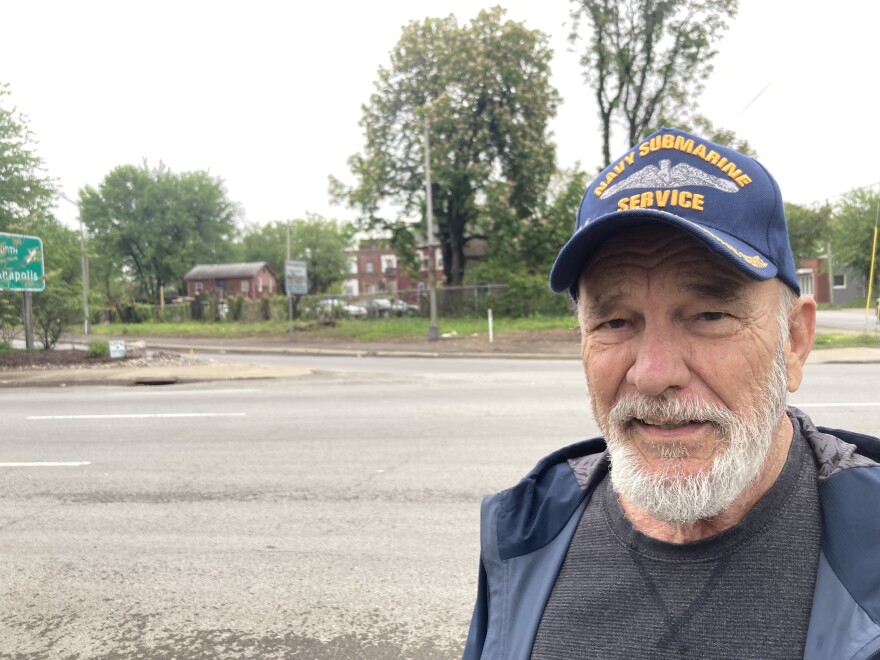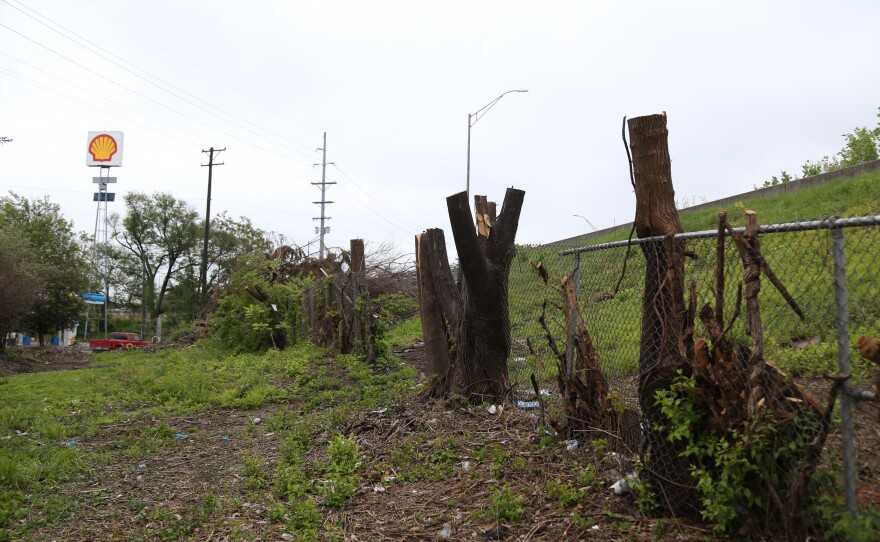Jay Singleton woke up to the sound of chainsaws clearcutting the trees behind his home on Floyd Street. His home backs up to Interstate 65 on-ramp on St. Catherine Street in Old Louisville. The trees had acted as a sound and pollution barrier.
“The tree barrier that used to cut down a lot of noise was basically decimated,” Singleton said. “Rush hour is horrible, that’s probably the loudest time.”
Last October, the Kentucky Transportation Cabinet revised statewide permitting rules for vegetation management along the sides of highways. The revisions create more flexibility for applicants and eliminate a requirement they hire a certified arborist.
In an April email shared with LPM News, a cabinet official said billboard companies in Louisville are applying to remove hundreds more trees they feel are blocking visibility of their billboards.
“It should be noted that the billboard companies in Louisville are currently in conversation to submit as many more permits just in Jefferson County for the removal of hundreds more trees that they feel are blocking the possibility of their billboards,” wrote Jason Richardson, cabinet engineer supervisor for district 5, in the email.

But due to the cost of pruning, Richardson wrote most companies request removal so they don’t have to continuously prune. For each tree cut down, companies are required to contribute a $50 to $100 conservation fee paid to the Kentucky Natural Lands Trust for the Imperiled Bat Mitigation Fund. That funding won’t necessarily come back to the county where the tree was cut, Richardson wrote.
Transportation cabinet spokesperson Chuck Wolfe said the cabinet is shifting vegetation management practices to become “more inclusive of habitat, particularly for Threatened, Endangered, or Candidate species as well as other naturally occurring species of plants and animals.”
According to Wolfe’s email, six permit applications have been approved statewide for vegetation removal for billboard visibility since 2015. Half of them were approved this year, including the permit to cut down trees along the on-ramp at St. Catherine and I-65. He said no other applications are pending.
Cutting trees along I-65
Lamar Advertising received a permit to cut down the trees behind Singleton’s house in order to improve the field of vision for drivers looking at their sign promoting Finlandia Vodka. Several of the clearcut trees appeared to be decades old.
Officials with Lamar did not immediately return a request for comment.
Louisville Climate Action Executive Director Sarah Lynn Cunningham pointed to the stumps and debris still strewn beside the interstate, and questioned why the state hadn’t done more to protect the public’s interest.
“I mean look at that one. That was a redbud. They don’t get very tall. There was no reason to cut that down,” Cunningham said.
The trees that line interstates are part of Louisville’s urban forest and play a critical role in the health and wellbeing of the city. Their shade helps cool the city in the hottest months -- which is especially important given Louisville is among the worst heat islands in the country. Their canopies and roots reduce the impacts of flooding. Their leaves dampen road noise and particulate matter pollution that increases the risk of heart disease, lung cancer and asthma.
Several studies, including from the University of Louisville, have demonstrated the relationship between trees and physical health. Roadside vegetation, in particular, has been shown to reduce the nearby pollution from vehicles.
Cunningham said she expected more from the state.
“My beef is with the transportation cabinet,” Cunningham said. “I expect Lamar to exploit whatever they can exploit, but I expect the state to protect the state’s property for the public interest, not the private interest.”
Singleton said it’s too late for the trees that shaded his home, but he would like to stop it from happening to others.
“Not only is it ugly. It’s noisy and perhaps, deadly,” he said.
Richardson with the transportation cabinet says Lamar is required to come back in and remove the stumps and re-grade the area.
This story has been updated to include additional information.






